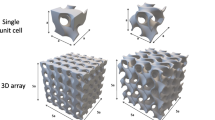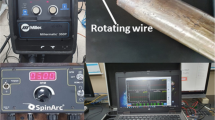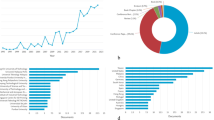Abstract
This experimental work investigates the combination of phase change material (PCM) with thermal storage units to combat excessive heat generation in high application hand-held conveniences. Four heat sink configurations including a no fin and three pin-fin arrays having pin diameters of 2 mm, 3 mm and 4 mm respectively are tested using four discreet volume fractions (0.0, 0.3, 0.6, 0.9) of n-eicosane as PCM under heavy usage power levels of 5–7 W. Round pins, made in aluminum, are incorporated in 9% volume percentage of sink’s bulk to act as thermal conductivity enhancer (TCE) in heat sinks. Parametric probe involved the impact of n-eicosane volume fractions, spatial variation of temperature, Fourier number (Fo), enhancement ratio, Modified Stephan number (Ste*), heat capacity as well as thermal conductance to provide for insights on superior thermal performance for distinct operating conditions of the hand-held. The outturns proclaimed that increasing volume fractions of PCM result in increased service time of the heat sinks. Effect of pin-fin configurations were found to be negligible on spatial temperature variation. Amongst all heat sinks, 3 mm pin-fin arrangement resulted in highest enhancement ratio, heat capacity & thermal conductance for all volume fractions of n-eicosane, thereby, demonstrated best thermal conduct of all four sink arrays.
















Similar content being viewed by others
Abbreviations
- Ψ :
-
PCM volume fraction
-
 PCM
:
PCM
: -
PCM volume, m3
- Vs :
-
heat sink volume, m3
- Vf :
-
total pin volume, m3
- Fo :
-
Fourier Number, Fo = ∝PCMtset/L2
- ∝PCM :
-
Thermal diffusivity (PCM), m2/s
- L :
-
sink length, m
- t set :
-
time required to reach SPT, min
- Θ ∗ :
-
Dimensionless temperature
- T ∗ set :
-
asymptotic set point temperature, °C
- T base :
-
average heat sink base temperature, °C
- T ∞. :
-
ambient temperature, °C
- Ste* :
-
Modified Stephan Number, Ste∗ = QCP/KPCM λh
- Q :
-
heat input, W
- C P :
-
specific heat (PCM), J/kg K
- K PCM :
-
thermal capacity of PCM, W/m K
- h :
-
sink height, m
- λ :
-
Latent heat (PCM), KJ/Kg
- Ф :
-
TCE volume fraction
- ξ :
-
Enhancement Ratio
- tCT(with TCE) :
-
Time to reach STP of finned heat sink
- tCT(without TCE) :
-
Time to reach STP of un-finned heat sink
- c :
-
Heat capacity, KJ/K
- Q :
-
Heat transferred, KJ
- △T :
-
Change in temperature, K
- G :
-
Thermal conductivity, W/K
- P :
-
Power, W
- Tmax :
-
Maximum temperature after heating phase, K
- Tamb :
-
Room temperature, K
- PCM :
-
phase change material
- TCE :
-
thermal conductivity enhancer
- CNC :
-
computer numeric control
- H :
-
thermocouples on heat sink base
- W :
-
thermocouples in side walls
- T :
-
thermocouples immersed in PCM
- TCE :
-
thermal conductivity enhancer
- PDA :
-
personal digital assistant
- LHTMS :
-
latent heat thermal management system
- TSU :
-
thermal storage unit
- TSE :
-
thermal energy storage
- NEPCM :
-
Nano-enhance phase change material
- TM :
-
thermal management
- MNCWT :
-
multi-wall carbon nanotubes
- GNT :
-
graphene nanoplatelets
- CNT:
-
carbon nanoplates
- CF:
-
carbon foam
- SPT:
-
set point temperature
References
Grimes R, Walsh E, Walsh P (2010) Active cooling of a mobile phone handset. Appl Therm Eng 30(16):2363–2369
Luo Z et al (2008) System thermal analysis for mobile phone. Appl Therm Eng 28(14–15):1889–1895
Sharma RK et al (2015) Developments in organic solid–liquid phase change materials and their applications in thermal energy storage. Energy Convers Manag 95:193–228
Tan FL, Tso CP (2004) Cooling of mobile electronic devices using phase change materials. Appl Therm Eng 24(2–3):159–169
Kandasamy R, Wang X-Q, Mujumdar AS (2008) Transient cooling of electronics using phase change material (PCM)-based heat sinks. Appl Therm Eng 28(8–9):1047–1057
Nayak KC et al (2006) A numerical model for heat sinks with phase change materials and thermal conductivity enhancers. Int J Heat Mass Transf 49(11–12):1833–1844
Fok SC, Shen W, Tan FL (2010) Cooling of portable hand-held electronic devices using phase change materials in finned heat sinks. Int J Therm Sci 49(1):109–117
Setoh G, Tan FL, Fok SC (2010) Experimental studies on the use of a phase change material for cooling mobile phones. International Communications in Heat and Mass Transfer 37(9):1403–1410
Saha SK, Srinivasan K, Dutta P (2008) Studies on optimum distribution of fins in heat sinks filled with phase change materials. J Heat Transf 130(3):034505
Pakrouh R et al (2015) A numerical method for PCM-based pin fin heat sinks optimization. Energy Convers Manag 103:542–552
Saha SK, Dutta P (2010) Heat transfer correlations for PCM-based heat sinks with plate fins. Appl Therm Eng 30(16):2485–2491
Hosseini SMJ et al (2013) Melting of Nanoprticle-enhanced phase change material inside Shell and tube heat exchanger. Journal of Engineering 2013:1–8
Levin PP, Shitzer A, Hetsroni G (2013) Numerical optimization of a PCM-based heat sink with internal fins. Int J Heat Mass Transf 61:638–645
Sebti SS et al (2013) Numerical study of the melting of nano-enhanced phase change material in a square cavity. Journal of Zhejiang University SCIENCE A 14(5):307–316
Alshaer WG et al (2015) Thermal management of electronic devices using carbon foam and PCM/nano-composite. Int J Therm Sci 89:79–86
Fan L-W et al (2015) Transient performance of a PCM-based heat sink with high aspect-ratio carbon nanofillers. Appl Therm Eng 75:532–540
Mahmoud S et al (2013) Experimental investigation of inserts configurations and PCM type on the thermal performance of PCM based heat sinks. Appl Energy 112:1349–1356
Baby R, Balaji C (2012) Experimental investigations on phase change material based finned heat sinks for electronic equipment cooling. Int J Heat Mass Transf 55(5–6):1642–1649
Baby R, Balaji C (2012) Thermal management of electronics using phase change material based pin fin heat sinks. J Phys Conf Ser 395:012134
Baby R, Balaji C (2013) Thermal optimization of PCM based pin fin heat sinks: an experimental study. Appl Therm Eng 54(1):65–77
Baby R, Balaji C (2014) Thermal performance of a PCM heat sink under different heat loads: an experimental study. Int J Therm Sci 79:240–249
Ali HM, Arshad A (2017) Experimental investigation of n-eicosane based circular pin-fin heat sinks for passive cooling of electronic devices. Int J Heat Mass Transf 112:649–661
Arshad A et al (2017) Thermal performance of phase change material (PCM) based pin-finned heat sinks for electronics devices: effect of pin thickness and PCM volume fraction. Appl Therm Eng 112:143–155
Ashraf MJ et al (2017) Experimental passive electronics cooling: parametric investigation of pin-fin geometries and efficient phase change materials. Int J Heat Mass Transf 115:251–263
Venkateshan SP (2015) Mechanical measurements 2nd edition. Available from: http://public.eblib.com/choice/publicfullrecord.aspx?p=2008061
B.N. Taylor, (1994) C. E. K., Guidelines for Evaluating and Expressing the Uncertainty of NIST Measurement Results, US Department of Commerce, Technology Administration, National Institute of Standards and Technology Gaithersburg, MD
Author information
Authors and Affiliations
Corresponding author
Ethics declarations
Conflict of interest
The authors of the article have no conflict of interest.
Additional information
Publisher’s Note
Springer Nature remains neutral with regard to jurisdictional claims in published maps and institutional affiliations.
Rights and permissions
About this article
Cite this article
Rukh, S., Pasha, R.A. & Nasir, M.A. Heat transfer enhancement of round pin heat sinks using N-eicosane as PCM: an experimental study. Heat Mass Transfer 55, 309–325 (2019). https://doi.org/10.1007/s00231-018-2411-6
Received:
Accepted:
Published:
Issue Date:
DOI: https://doi.org/10.1007/s00231-018-2411-6





 PCM
:
PCM
: